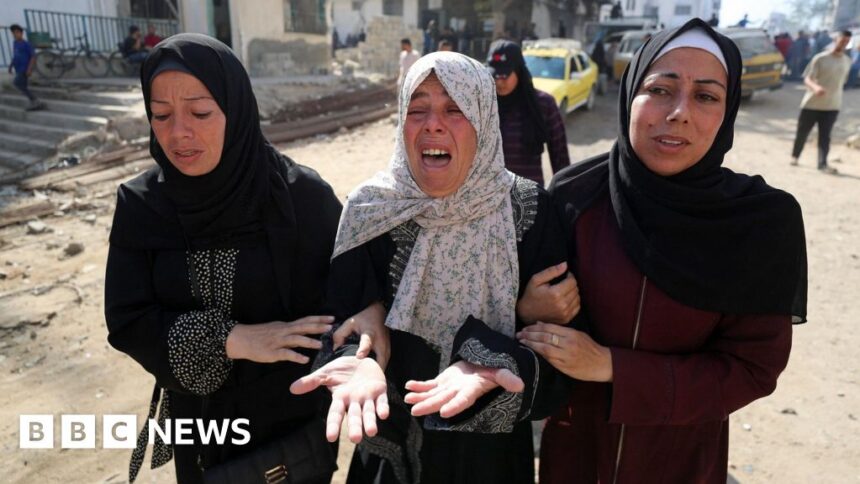I’ve spent the past 72 hours moving between makeshift shelters in southern Gaza, where thousands of families displaced multiple times now face a new wave of Israeli bombardment. Yesterday’s strikes on Deir al-Balah killed at least 21 people, according to health officials, including nine children from a single family.
“We were told to evacuate to this ‘safe zone’ three weeks ago,” Mahmoud Saleh told me as he searched through rubble for family possessions. “This is the fourth time we’ve been forced to move. Where exactly are we supposed to go now?”
The Israeli military dropped leaflets yesterday ordering civilians to evacuate parts of central Gaza, areas previously designated as humanitarian zones. These contradictory directives have created chaos among already traumatized populations, with the UN estimating over 85% of Gaza’s 2.3 million residents are now internally displaced.
Defense Minister Yoav Gallant justified the expanded operations as necessary to “eliminate Hamas infrastructure” following intelligence about militant activities in these areas. However, humanitarian organizations on the ground report these zones are overwhelmingly civilian, with limited access to food, medicine, or clean water.
At Al-Aqsa Hospital, I witnessed doctors working by mobile phone light during power outages. Dr. Kamal Adwan described treating children with severe burns without adequate medical supplies. “We’re performing surgeries without anesthesia,” he said. “The international community speaks of humanitarian aid, but what reaches us is a fraction of what’s needed.”
The World Health Organization confirms only 16 of Gaza’s 36 hospitals remain partially functional. Their spokesperson told me yesterday that medical facilities “are operating at 300% capacity with critical shortages of everything from antibiotics to fuel for generators.”
Economic analysts at the World Bank estimate reconstruction costs already exceed $18.5 billion – roughly four times Gaza’s annual GDP before the conflict began. Meanwhile, humanitarian access remains severely constrained despite diplomatic pressure.
A diplomatic source at the United Nations, speaking on condition of anonymity, expressed frustration with the impasse: “Every Security Council resolution on humanitarian corridors has been effectively ignored. The political will to enforce these agreements simply isn’t there.”
On the Israeli side, domestic pressure has mounted on Prime Minister Netanyahu to show progress in the stated objective of dismantling Hamas. Recent polls show declining support for the military campaign as Israeli hostage families increase their demands for negotiated solutions.
The strategic calculus appears increasingly complex. While Israel maintains it must continue operations to prevent Hamas from regrouping, regional stability continues deteriorating. Jordan’s Foreign Minister Ayman Safadi warned yesterday that the humanitarian catastrophe “threatens to destabilize the entire region for generations.”
For 12-year-old Fatima, whom I found searching for clean water near a damaged UN distribution center, these geopolitical considerations mean little. “I haven’t been to school in months,” she told me while filling a small container from a leaking pipe. “I don’t know if our apartment still exists. My father disappeared during an airstrike last month.”
Her story echoes thousands of others in what the International Rescue Committee now describes as “the world’s worst humanitarian crisis.” Their latest assessment indicates acute malnutrition rates have tripled since October, with children particularly vulnerable.
As night fell on Deir al-Balah, more families arrived carrying whatever possessions they could manage – mattresses, cooking pots, family documents. Aid workers distributed thin blankets as temperatures dropped, knowing full well their supplies would reach only a fraction of those in need.
“The cycle of displacement creates cascading health crises,” explained Dr. Sarah Levine from Médecins Sans Frontières. “We’re seeing outbreaks of hepatitis A, skin diseases, and respiratory infections from overcrowded conditions. Prevention becomes impossible when basic sanitation collapses.”
The diplomatic stalemate continues despite Egyptian and Qatari mediation efforts. Yesterday’s talks in Cairo ended without breakthrough on either hostage releases or humanitarian pauses. Meanwhile, the human toll mounts daily.
As I filed this report, new airstrikes illuminated the sky over Khan Younis. For Gaza’s civilians caught between military objectives and survival, each day brings new calculations about where safety might be found – calculations that increasingly have no good answers.






